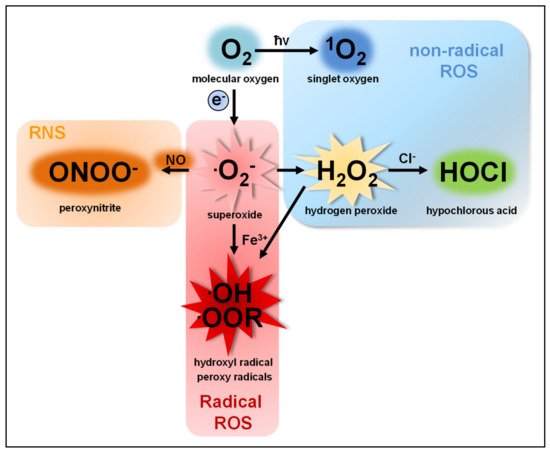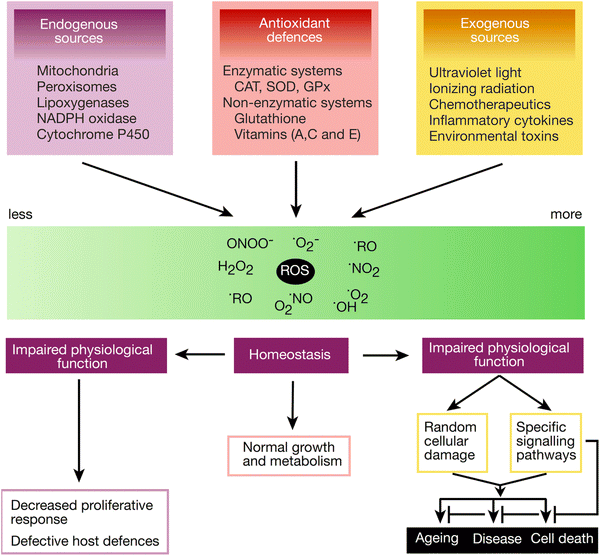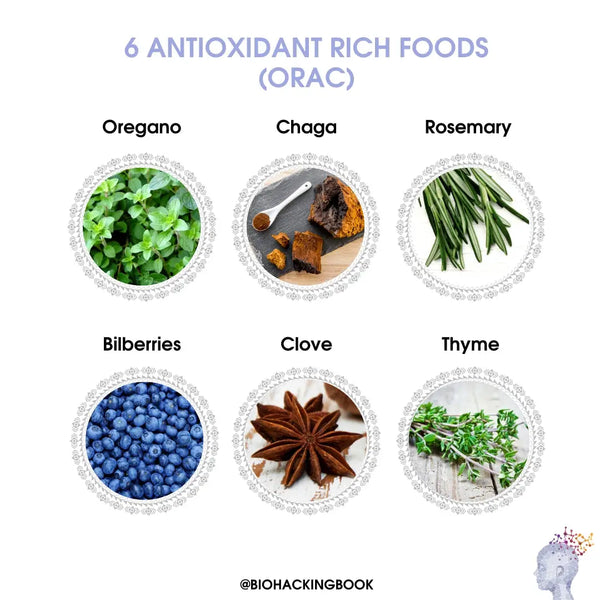Oksidatiivinen stressi on solutason stressiä
Oksidatiivinen stressi on elimistössä luonnollinen biokemiallinen ilmiö, joka voi yli-ilmentyessään johtaa solutason epätasapainoon, joka ulottuu koko kehoon. Hapetusstressiä voidaan tarkastella redox-reaktion (pelkistys-hapetus) kautta. Se on kemiallinen reaktio, jossa yksi tai useampi elektroni siirtyy kokonaan tai osittain atomista toiseen. Tällaisessa reaktiossa elektroneja luovuttava aine hapettuu ja elektroneja vastaanottava aine pelkistyy.
Käytännössä oksidatiivinen stressi tarkoittaa sitä, että solut altistuvat liian suurelle osalle hapetusreaktiota. Tämä epätasapaino johtuu siitä, että kehossa on liikaa hapettavia tekijöitä tai elimistön antioksidanttikapasiteetti eli pelkistystekijöiden reservi. Ihannetapauksessa näiden välillä on tasapaino, joka tukee luonnollista homeostaasia.
Oksidatiivisessa stressissä reaktiivisten ja vapaiden happiradikaalien määrä kasvaa (reaktiivisten happilajien eli ROS:n määrä lisääntyy). Happiatomeja sisältävissä molekyyleissä on pariton ja vapaa elektroni, mikä tekee niistä erittäin epävakaita ja lyhytikäisiä. Vapaiden happiradikaalien muodostuminen kehossa on normaalia, mutta niistä tulee suuria määriä terveydelle haitallisia. Pitkittynyt oksidatiivinen stressi lisää solukuolemaa , mikä voi ääritapauksissa johtaa kudosten nekroosiin .

Happiradikaaleja tuotetaan kehossa mitokondrioiden energia-aineenvaihdunnassa (soluhengitys), maksan sytokromi P450 -entsyymeissä ja monissa muissa solun oksidatiivisissa tapahtumissa. Ulkoisia happiradikaalien lähteitä ovat ilmansaaste, säteily, savu, monet lääkkeet, kuten kemoterapia ja ksenobiootit, tai muut keholle vieraat aineet. Oksidatiivista stressiä aiheuttavat myös sytokiinit erilaisissa tulehdustiloissa ja esimerkiksi bakteeri-infektioissa . Yleisimmät reaktiiviset happilajit ovat superoksidianioni (O2−), peroksidit, kuten vetyperoksidi (H2O2), hydroksyyliradikaali (OH), alkoksidiradikaalit (RO), peroksidiradikaalit (RO) ja peroksinitriitti (ONOO-) (katso kuva alla ).

Kuvan lähde : Herb, M., & Schramm, M. (2021). ROS:n toiminnot makrofageissa ja antimikrobinen immuniteetti. Antioksidantit 10 (2): 313.
Vapaiden happiradikaalien ylikuormitus on liitetty moniin erilaisiin sairauksiin niiden solutason haitallisten vaikutusten vuoksi (lipidiperoksidaatio eli rasvan härskiintyminen, proteiinivauriot ja DNA-vauriot). Oksidatiivisella stressillä on merkittävä rooli sepelvaltimotaudin , masennuksen , erilaisten autoimmuunisairauksien, infektioiden, syövän ja monien hermostoa rappeuttavien sairauksien , kuten Parkinsonin taudin , kehittymisessä . Pitkittynyt liiallinen oksidatiivinen stressi liittyy myös väsymykseen ja jatkuvaan uupumukseen .
Oksidatiivinen stressi ja telomeerien lyheneminen
Telomeeri on DNA-sekvenssi kaikkien kromosomien päässä. Sen tehtävänä on suojata kromosomia ja soluja muun muassa oksidatiiviselta stressiltä ja rappeutumista vastaan. Jokaisessa eukaryoottisolussa on 46 kromosomia ja yhteensä 92 telomeeriä niiden päissä. Telomeerit huolehtivat kaikesta solun jakautumisesta ja DNA-tiedot kopioidaan uuteen soluun. Tiedetään myös, että telomeeri lyhenee aina hieman jokaisen jakautumisen yhteydessä – ne voivat jakautua noin 50–70 kertaa, minkä jälkeen solut eivät enää pysty jakautumaan vaan kuolevat (ns. Hayflick-raja ).
Nobel-palkittu ja australialainen molekyylibiologian tohtori Elizabeth Blackburn, joka on tutkinut telomeerejä vuosikymmeniä, on havainnut tutkimuksessaan, että pitkäaikainen stressi nopeuttaa telomeerien lyhentymistä. Psykologinen stressi näyttää lisäävän oksidatiivista stressiä solutasolla . Vuonna 2010 julkaistussa laajassa tutkimuksessa Blackburn havaitsi, että meditaatio voi hidastaa ikääntymistä. Matalaa oksidatiivista stressiä ja korkeampaa telomeraasientsyymiaktiivisuutta, jotka estävät telomeerien lyhenemisen, on havaittu pitkäaikaisilla meditoijilla .

Kuva : Telomeerien hankaus, telomeerin pituus ja telomeraasi.
Lähde : Vaiserman, A., & Krasnienkov, D. (2021). Telomeerien pituus biologisen iän merkkinä: uusinta tekniikkaa, avoimia kysymyksiä ja tulevaisuuden näkökulmia. Frontiers in Genetics 11: 1816.
Vapaat happiradikaalit eivät kuitenkaan ole vain uhka terveydelle. Tietyissä tilanteissa ne suojaavat myös erilaisilta infektioilta ja toimivat siten osana immuunijärjestelmää . Lyhytaikainen oksidatiivinen stressi voi myös suojata kehoa mitohormeesin aiheuttamalta ikääntymiseltä .
MITOHORMESIS
Mitohormesis on termi, jota käytetään määrittelemään biologinen vaste, jossa mitokondrioiden stressi johtaa terveyden ja elinkyvyn paranemiseen solussa, kudoksessa tai koko organismissa. Mahdollisesti vahingollisen ärsykkeen aktivoima mitokondrioiden stressivaste vaatii koordinoitua vuoropuhelua solun ytimen kanssa ( mitonuclear communication ). Tämä mitokondrioiden hormeettisen vasteen aiheuttama yhteistyö perustuu useisiin signaaleihin, joista tärkeimmät ovat reaktiiviset happilajit (ROS).
Myös mitokondrioiden metaboliiteilla, proteotoksisilla signaaleilla, mitokondrioiden ja sytosolien stressivasteella ja mitokiinien vapautumisella on merkittävä rooli tässä prosessissa. Mitohormeesin aktivoitumisen on todettu pidentävän elinikää eläinmalleissa ja se lisää myös terveyttä parantamalla aineenvaihduntaa ja immuunijärjestelmää .
Antioksidantit oksidatiivisen stressin tasapainottamisessa
Oksidatiivisen stressin hypoteesin mukaan 1950-luvulta pitkälle 1990-luvulle uskottiin, että antioksidantit olivat tehokkaita lähes kaikkien sairauksien hoidossa. Oksidatiivisen stressin uskottiin myös liittyvän olennaisesti ikääntymiseen. Tätä kutsutaan vapaaradikaali ikääntymisen teoriaksi (FRTA) . Sittemmin on ymmärretty paremmin, että antioksidanttien käyttö ei yksin takaa terveyttä ja että monet sairaudet johtuvat oksidatiivisesta stressistä sekä muista taustalla olevista tekijöistä.
Antioksidanteilla on kuitenkin paikkansa jokaisen ruokavaliossa, sillä liiallinen oksidatiivinen stressi ja heikko antioksidanttikapasiteetti ovat haitallisia elimistölle. Antioksidantteja saadaan ruoasta, mutta kehossa on myös sisäisesti tuotettuja antioksidantteja, jotka yleensä riittävät tasapainottamaan normaalia oksidatiivista stressiä.
Ruoan tärkeimmät antioksidantit ovat C-vitamiini, A-vitamiini (karotenoidit, kuten beetakaroteeni) ja E-vitamiini. Terveyttä edistäviä tutkimustuloksia ravinnon antioksidanteista ovat astaksantiini , lykopeeni ja vihreä tee (erityisesti sen epigallokatekiini-3-gallaatti, ECGC) .

Kuvan lähde : Krumova, K. & Gonzalo, C. (2016). Yleiskatsaus reaktiivisiin happilajeihin. Singlet Oxygen: Sovelluksia biotieteissä ja nanotieteissä 1: 1–21. Lontoo: Royal Society of Chemistry.
Tärkeimpiä kehon sisäisiä antioksidantteja ovat superoksididismutaasi (SOD), glutationisulfhydryyli (GSH), koentsyymi Q10, katalaasi ja glutationiperoksidaasi. Peroksidroksiineilla ja sulfiredoksiinilla on myös tärkeä rooli. Muita tärkeitä endogeenisiä antioksidantteja ovat alfa-lipoiinihappo, ferritiini, uraatti, bilirubiini, metallotioneiini, L-karnitiini ja melatoniini.
Oksidatiivisen stressin ja kehon antioksidanttikapasiteetin välinen suhde voidaan mitata tarkasti useilla laboratoriomenetelmillä (katso myöhemmin).
ORAC
Ns. ORAC-arvo ilmaisee ruoan tai elintarvikkeen antioksidanttipitoisuuden. Lyhenne ORAC tulee englannin sanoista Oxygen Radical Absorbance Capacity , joka tarkoittaa kykyä vähentää vapaita happiradikaaleja. Arvo saadaan esimerkiksi tutkimalla kasvia tai marjaa koeputkessa ( in vitro ) ja sen reaktiota superoksidianionin kanssa . ORAC-arvo on siis suuntaa-antava luku, joka ei kerro suoraan ruoan antioksidanttipotentiaalista kehossa.
Eri arvioiden mukaan elimistö tarvitsee 3 000 - 5 000 ORAC-yksikköä päivässä suojellakseen soluja oksidatiiviselta stressiltä.

Vuonna 2012 USDA poisti ORAC-arvon elintarvikkeilta sen riittämättömien terveystodistusten vuoksi. Siksi on epäselvää, voidaanko ORAC-arvoa käyttää suoraan ruoan terveyshyötyjen arvioimiseen.
Ruokavalion antioksidanteilla on myös monia muita etuja kuin niiden vaikutus vapaisiin happiradikaaleihin. Yhdistämällä marjojen, vihannesten, hedelmien, mausteiden ja sienten, kuten kurpitsan, ominaisuuksia voidaan saavuttaa suojaa hapettumisstressiltä yleisen terveyden tukena.
Oksidatiivisen stressin mittaaminen
Oksidatiivinen stressi on epätasapaino vapaiden radikaalien tuotannon ja olemassa olevan antioksidanttikapasiteetin välillä (tunnetaan myös nimellä redox-tasapaino). Yleensä vapaiden radikaalien muodostumisen väheneminen johtuu lisääntyneestä antioksidanttikapasiteetista, ja vastaava antioksidanttikapasiteetin väheneminen voi liittyä vapaiden happiradikaalien lisääntyneeseen tuotantoon. Näitä pitoisuuksia määrittämällä voidaan tarkastella tarkemmin hapetus-pelkistysreaktioiden tasapainoa eli yleistä oksidatiivista stressitilaa .
Oksidatiivisen stressin tasoa voidaan arvioida myös muilla laboratoriotutkimuksilla. Tärkeimmät oksidatiivista stressiä mittaavat tutkimukset on esitetty alla olevassa taulukossa.
Taulukko : Oksidatiivista stressiä kuvaavat laboratoriomerkit.
|
Merkki |
Toiminta |
Viitealue ja optimaalinen alue |
|
|
|
|
|
|
|
||
|
FRAS-testi (Free Radical Analytical System) |
|
|
|
///




